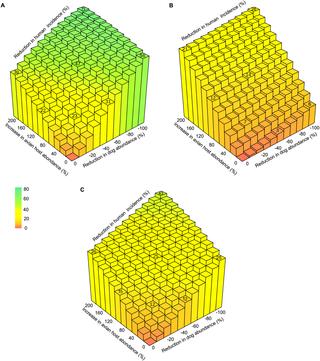当前位置:
X-MOL 学术
›
PLOS Negl. Trop. Dis.
›
论文详情
Our official English website, www.x-mol.net, welcomes your feedback! (Note: you will need to create a separate account there.)
Trypanosoma cruzi transmission dynamics in a synanthropic and domesticated host community.
PLOS Neglected Tropical Diseases ( IF 3.8 ) Pub Date : 2019-12-13 , DOI: 10.1371/journal.pntd.0007902 Alheli Flores-Ferrer 1 , Etienne Waleckx 2, 3 , Guilhem Rascalou 1 , Eric Dumonteil 4 , Sébastien Gourbière 1, 5
PLOS Neglected Tropical Diseases ( IF 3.8 ) Pub Date : 2019-12-13 , DOI: 10.1371/journal.pntd.0007902 Alheli Flores-Ferrer 1 , Etienne Waleckx 2, 3 , Guilhem Rascalou 1 , Eric Dumonteil 4 , Sébastien Gourbière 1, 5
Affiliation

|
Trypanosoma cruzi is the causative agent of Chagas disease, a Neglected Tropical Disease affecting 8 million people in the Americas. Triatomine hematophagous vectors feed on a high diversity of vertebrate species that can be reservoirs or dead-end hosts, such as avian species refractory to T. cruzi. To understand its transmission dynamics in synanthropic and domesticated species living within villages is essential to quantify disease risk and assess the potential of zooprophylaxis. We developed a SI model of T. cruzi transmission in a multi-host community where vector reproduction and parasite transmission depend on a triatomine blood-feeding rate accounting for vector host preferences and interference while feeding. The model was parameterized to describe T. cruzi transmission in villages of the Yucatan peninsula, Mexico, using the information about Triatoma dimidiata vectors and host populations accumulated over the past 15 years. Extensive analyses of the model showed that dogs are key reservoirs and contributors to human infection, as compared to synanthropic rodents and cats, while chickens or other domesticated avian hosts dilute T. cruzi transmission despite increasing vector abundance. In this context, reducing the number of dogs or increasing avian hosts abundance decreases incidence in humans by up to 56% and 39%, respectively, while combining such changes reduces incidence by 71%. Although such effects are only reached over >10-years periods, they represent important considerations to be included in the design of cost-effective Integrated Vector Management. The concomitant reduction in T. cruzi vector prevalence estimated by simulating these zooprophylactic interventions could indeed complement the removal of colonies from the peridomiciles or the use of insect screens that lower vector indoor abundance by ~60% and ~80%. These new findings reinforce the idea that education and community empowerment to reduce basic risk factors is a cornerstone to reach and sustain the key objective of interrupting Chagas disease intra-domiciliary transmission.
中文翻译:

克氏锥虫在同种和驯化宿主群落中的传播动态。
克氏锥虫是南美锥虫病的病原体,南美锥虫病是一种被忽视的热带疾病,影响着美洲 800 万人。锥蝽吸血媒介以多种脊椎动物物种为食,这些脊椎动物物种可以是储存宿主或死端宿主,例如对克氏锥蝽有抵抗力的鸟类物种。了解其在村庄内的同生和驯化物种中的传播动态对于量化疾病风险和评估动物预防的潜力至关重要。我们开发了克氏锥虫在多宿主群落中传播的 SI 模型,其中媒介繁殖和寄生虫传播取决于锥蝽吸血率,考虑了媒介宿主偏好和进食时的干扰。利用过去 15 年积累的有关锥蝽媒介和宿主种群的信息,对模型进行参数化,以描述墨西哥尤卡坦半岛村庄中的克氏锥蝽传播情况。对模型的广泛分析表明,与共生啮齿动物和猫相比,狗是人类感染的关键宿主和贡献者,而鸡或其他驯养鸟类宿主尽管载体丰度增加,但仍会稀释克氏锥虫的传播。在这种情况下,减少狗的数量或增加鸟类宿主的数量,可以分别使人类的发病率降低高达 56% 和 39%,而将这些变化结合起来,可以使发病率降低 71%。尽管这种效果只能在 10 年以上的时间内达到,但它们代表了设计具有成本效益的综合病媒管理时应考虑的重要因素。通过模拟这些动物预防干预措施估计的克氏锥虫病媒流行率的相应减少确实可以补充从周围住所中清除菌落或使用昆虫屏障,从而将病媒室内丰度降低约 60% 和约 80%。这些新发现强化了这样的观点:减少基本风险因素的教育和社区赋权是实现和维持阻断恰加斯病家庭内传播这一关键目标的基石。
更新日期:2019-12-17
中文翻译:

克氏锥虫在同种和驯化宿主群落中的传播动态。
克氏锥虫是南美锥虫病的病原体,南美锥虫病是一种被忽视的热带疾病,影响着美洲 800 万人。锥蝽吸血媒介以多种脊椎动物物种为食,这些脊椎动物物种可以是储存宿主或死端宿主,例如对克氏锥蝽有抵抗力的鸟类物种。了解其在村庄内的同生和驯化物种中的传播动态对于量化疾病风险和评估动物预防的潜力至关重要。我们开发了克氏锥虫在多宿主群落中传播的 SI 模型,其中媒介繁殖和寄生虫传播取决于锥蝽吸血率,考虑了媒介宿主偏好和进食时的干扰。利用过去 15 年积累的有关锥蝽媒介和宿主种群的信息,对模型进行参数化,以描述墨西哥尤卡坦半岛村庄中的克氏锥蝽传播情况。对模型的广泛分析表明,与共生啮齿动物和猫相比,狗是人类感染的关键宿主和贡献者,而鸡或其他驯养鸟类宿主尽管载体丰度增加,但仍会稀释克氏锥虫的传播。在这种情况下,减少狗的数量或增加鸟类宿主的数量,可以分别使人类的发病率降低高达 56% 和 39%,而将这些变化结合起来,可以使发病率降低 71%。尽管这种效果只能在 10 年以上的时间内达到,但它们代表了设计具有成本效益的综合病媒管理时应考虑的重要因素。通过模拟这些动物预防干预措施估计的克氏锥虫病媒流行率的相应减少确实可以补充从周围住所中清除菌落或使用昆虫屏障,从而将病媒室内丰度降低约 60% 和约 80%。这些新发现强化了这样的观点:减少基本风险因素的教育和社区赋权是实现和维持阻断恰加斯病家庭内传播这一关键目标的基石。


























 京公网安备 11010802027423号
京公网安备 11010802027423号